The double-decker train glided into Kaunas station right on schedule, sleek and spotless, promising a journey as efficient as it was scenic. We had read that Lithuanian trains were among the best in Europe—and they didn’t disappoint. Boarding Car 1, we climbed to our reserved seats on the upper level, ready to soak in the sweeping views of the countryside. This was the final leg of our ‘retiring in the Baltics’ scouting mission—a ten-day journey through Lithuania exploring the lifestyles of Vilnius, Kaunas, and Klaipėda.
Here’s what our exploration revealed:
Top Communities in Lithuania for Retirees
Vilnius
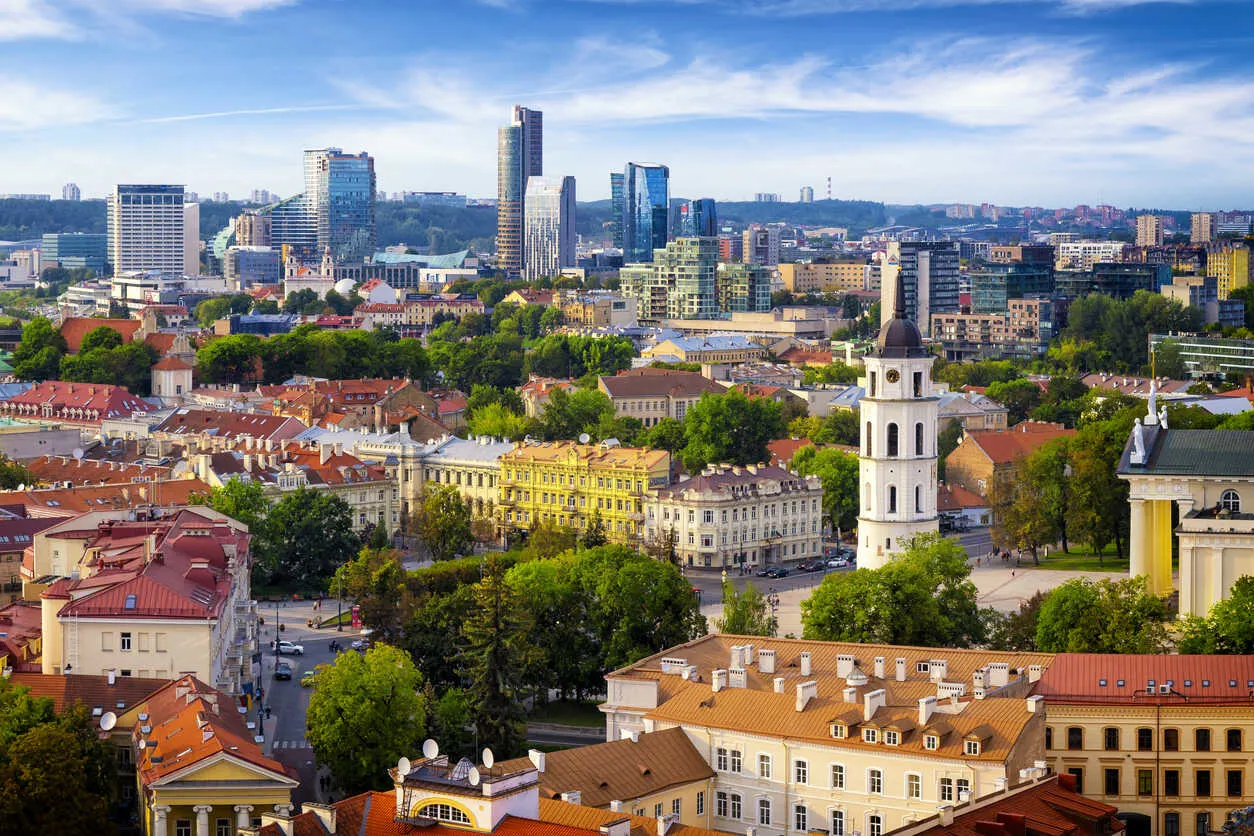
Vilnius is located in southeastern Lithuania, near the Neris River. The city has a population of 542,000 and is growing at a rate of 0.18 percent.
Vilnius, the capital of Lithuania, is an energetic city with a vivid history and a unique blend of architectural styles. The city’s Old Town is a UNESCO World Heritage site, with narrow cobblestone streets, medieval buildings, and Baroque churches. In the over 35 museums, you can learn about history, science, transportation, art, and much more.
Vilnius is known for its cultural diversity, which has been influenced by various civilizations, including the Polish, Jewish, and Russian communities.
The city boasts an active arts and music scene, with numerous galleries, theaters, and venues showcasing traditional and contemporary works. Vilnius also offers a variety of outdoor activities, such as exploring the many parks, taking a leisurely stroll along the Neris River, or visiting the nearby lakes and forests for a peaceful retreat.
In addition to its cultural and natural attractions, Vilnius provides a high quality of life at an affordable cost compared to other European capitals. The city offers a range of dining options, from traditional Lithuanian cuisine to international fare, as well as bustling markets and modern shopping centers.
Overall, Vilnius is a city that combines its rich heritage with modern living, making it an appealing destination for retirees and travelers.
Kaunas
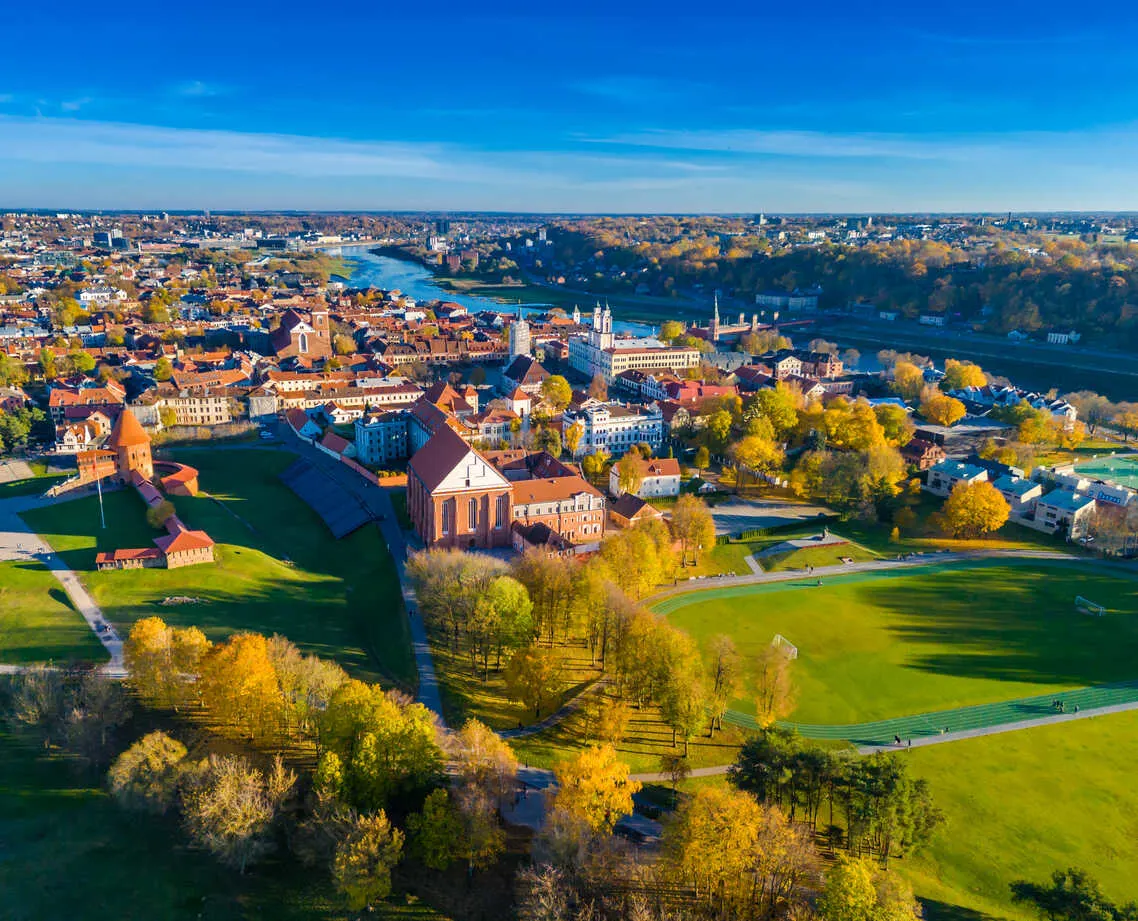
Kaunas is located in central Lithuania, near major transport routes. Its population was 289,380 in 2024, and the average age was 42. Kaunas, the second-largest city in Lithuania, offers an active lifestyle characterized by a blend of historic and modern.
With its central location, Kaunas is a hub of culture, education, and commerce. Residents enjoy various activities, from exploring historical sites, like the Kaunas Castle and the Art Deco architecture, to attending cultural events and festivals.
The city has numerous parks and riverside promenades, promoting an active outdoor life. With affordable living costs, diverse dining options, and a growing arts scene, Kaunas is an appealing choice if you want an abundant cultural experience and a welcoming community.
Klaipėda
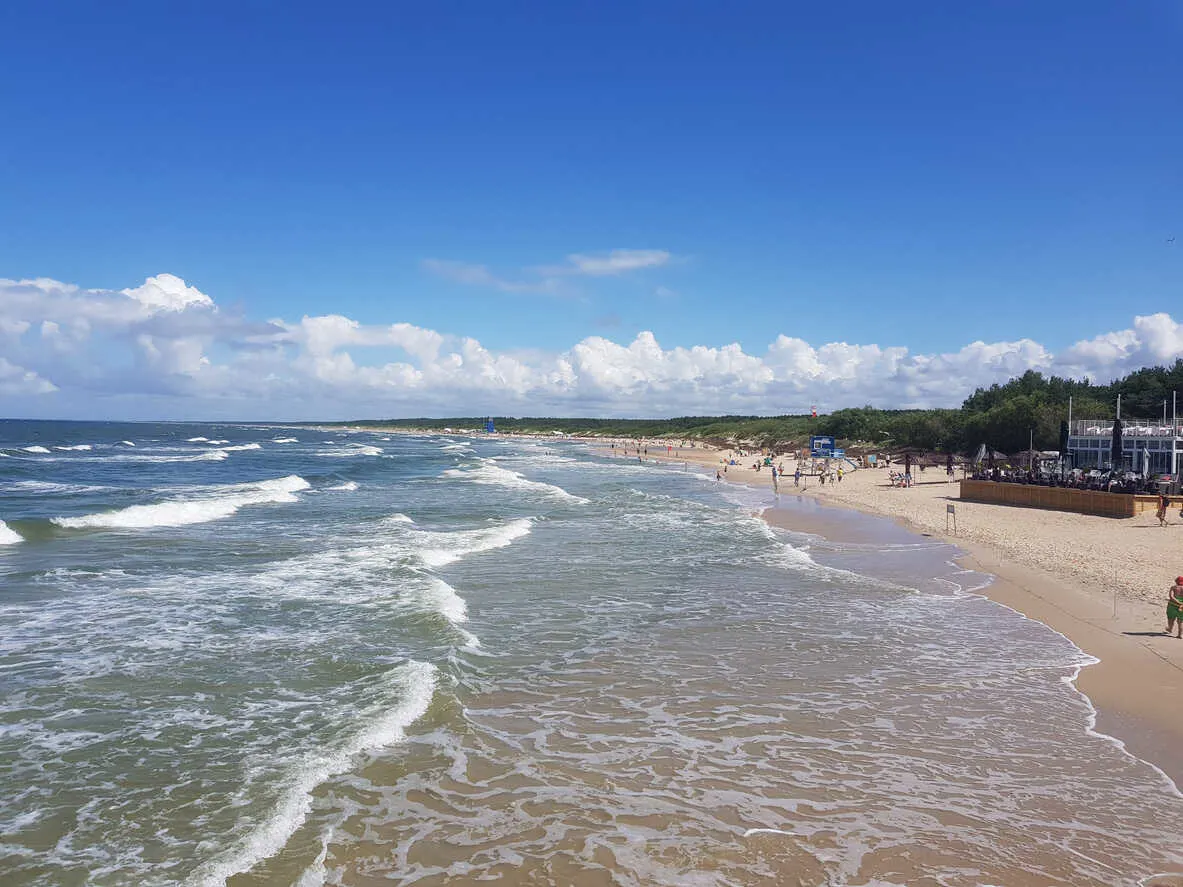
Klaipėda, located on Lithuania’s northwest coast, is the country’s only port city, bordered by the Baltic Sea and the Curonian Lagoon. The population is 159,396, and the average age is 45.
Klaipėda has a diverse ethnic makeup, reflecting the city’s historical influences. The predominant group is ethnic Lithuanians, but the city is also home to significant Polish, Russian, and Belarusian communities. Additionally, smaller groups of Ukrainians, Jews, and Germans can be found in the region. This multicultural backdrop contributes to the city’s culture and community life. Klaipėda offers a lifestyle influenced by its coast and cultural heritage.
As Lithuania’s only port city, it blends historical influences with modern amenities. Residents enjoy a range of outdoor activities on beaches and nature trails along the Baltic Sea and Curonian Lagoon. The city hosts numerous cultural events associated with its diverse ethnic makeup.
With affordable living costs, a variety of dining options, and a lively arts scene, Klaipėda is an attractive destination for retirees seeking a balanced, community-oriented lifestyle.
How To Move Out of the U.S.
How To Move Out of the U.S.
The policy implications of the last election impacted your retirement funds, taxes, healthcare, and more. But you can protect yourself, your family, your future. In lots of safe, warm, friendly spots abroad, you can live comfortably on a budget from $2,000-$3,800 a month (all-in—housing and extras included). We’ll show you how—and where—to go.

By submitting your email address, you will receive a free subscription to IL Postcards, The Untourist Daily and special offers from International Living and our affiliates. You can unsubscribe at any time, and we encourage you to read more about our Privacy Policy.
Cost of Living in Lithuania
| Average Living Expenses* | US$ |
| Monthly rent for a 900 sq ft furnished apartment in an expensive area. | 1530 |
| Monthly rent for a 900 sq ft furnished apartment in an average area. | 801 |
| Monthly utilities – electricity, heating, cooling, water, and garbage for two people in a 900 sq ft apartment. | 205 |
| Monthly high-speed Internet. | 15 |
| Monthly mobile phone – 4G network. | 14 |
| Monthly public transit ticket. | 32 |
| One liter gasoline (1/4 gallon). | 1.46 |
| Monthly groceries for two, 2400 calories per person per day. | 499 |
| Dining out – a three-course dinner in a mid-range restaurant | 66 |
| Cinema | 20 |
| Cocktail | 20 |
| Beer | 10 |
| Cappuccino | 7 |
*All numbers are the average costs in Lithuania, converted from Euro to US$ at the exchange rate on 10/14/24 and rounded to the nearest dollar.
Shopping in Lithuania
Lithuania’s currency is the Euro, and debit and credit cards are widely accepted. Shopping in Lithuania offers traditional shops, markets, and modern retail stores. In cities like Vilnius and Kaunas, you can explore busy street markets where local vendors sell fresh produce, handmade crafts, and traditional Lithuanian delicacies like kibinai, pastries filled with ground meat, onion, and sour cream, or cepelinai, a dumpling made from potato and ground meat.
Supermarkets offer a wide range of products at affordable prices. As in any country, imported goods are more costly than local products. Labels are in Lithuanian, as a rule. Some products have an English translation. Use Google Translate to get what you need when you shop.
Shopping centers have international brands and unique boutiques selling local designers. There are souvenir shops, perfect for picking up amber jewelry or artisanal goods.
Personal Note: We fell in love with amber while in Lithuania, stopping into every shop that displayed it in its window. Our favorite stop was the Amber Museum and Gallery in Vilnius. We learned about amber there from a knowledgeable docent who warned us about the ‘fake’ amber often sold in souvenir shops. We found a heart pendant that fit our budget at the museum gift shop. It is a treasured memory.
Taxes in Lithuania
Income tax in Lithuania is 20–32%, depending on income. However, Lithuania and the US government have a no-double-tax treaty.
Location, History, and Culture
Lithuania is located in Northern Europe, bordered by the Baltic Sea to the west. It shares land borders with Latvia to the north, Belarus to the east and south, and Poland and the Russian exclave of Kaliningrad to the southwest.
Lithuania has a diverse landscape, including forests, lakes, and rivers. Major cities like Vilnius, Kaunas, and Klaipėda highlight its cultural and historical significance. Lithuania’s position at the crossroads of Eastern and Western Europe has shaped its heritage, making it a blend of several influences throughout its history.
Brief History
Lithuania’s history is prolific and complex, marked by moments of independence and foreign domination. Established in the 13th century, the Grand Duchy of Lithuania became one of the largest countries in Europe, expanding significantly during the Middle Ages. In 1569, it formed a union with Poland, creating the Polish-Lithuanian Commonwealth, which flourished culturally and politically but eventually declined in the 18th century.
Partitions by neighboring powers led to the loss of sovereignty, with Lithuania enduring Russian and Prussian rule. The desire for independence in the 19th century culminated in the Declaration of Independence in 1918.
However, Lithuania was occupied by the Soviet Union in 1940, followed by Nazi Germany, and then reoccupied by the Soviets after World War II. After years of struggle, Lithuania regained its independence in 1990. It became a member of the European Union and NATO and emerged as a democracy.
The Lithuanian People
Lithuanians are known for their rich cultural heritage and strong national identity. They are primarily of ethnic Lithuanian descent, but the country also hosts significant Polish, Russian, and Belarusian communities. Lithuanians take pride in their language, one of the oldest in Europe, and their cultural traditions, including folk music and dance.
Lithuanians offer warm hospitality and a strong community spirit. Family and friendships play a vital role in everyday life. Despite historical challenges, including periods of foreign domination, Lithuanians have a resilient spirit and a passion for celebrating their culture through festivals, art, and cuisine.
Lithuanians are friendly, resourceful, and deeply connected to their roots, making the country a welcoming place for visitors and retirees.
Food & Drink
Lithuanian food is hearty and full of flavor, reflecting the country’s agricultural roots and varied history. Staples include barley, potatoes, rye, beets, greens, berries, and mushrooms. Fish and meats also figure prominently. One of the most beloved dishes is cepelinai, or potato dumplings stuffed with minced meat, often served with sour cream. Another favorite is šaltibarščiai, a vibrant cold beet soup perfect for hot summers.
Traditional baking is prominent, with honey and poppy seeds used in pastries. Festivals often feature kugelis, a potato pudding, and various pickled vegetables, highlighting seasonal ingredients. Lithuanian cuisine offers a warm and comforting experience, rich in tradition and taste.
Lithuania has a long tradition of alcoholic beverages, particularly local wines, beers, and spirits. Wine production is limited, but several wineries craft fruit wines, often made from local fruit, like currants and apples.
Lithuanian beer has a long-standing heritage, with various ales and lagers brewed in small craft breweries and larger establishments. Popular lines include light and dark varieties, often enjoyed with traditional foods.
Local spirits, particularly šnipinys (a type of vodka) and midus (mead), highlight the nation’s artisanal approach. They feature natural ingredients from the country’s landscape and culture.
Language
Lithuanian is one of the oldest languages in Europe, belonging to the Baltic branch of the Indo-European language family. It retains many archaic features, making it a valuable resource for linguists studying the evolution of languages.
Lithuanian has a complex grammar, with a system of cases that influences how words interact in sentences. Due to historical connections, the language has been influenced by Polish, Russian, and German. Today, it is spoken primarily in Lithuania, which plays a vital role in national identity.
The most commonly spoken foreign language in Lithuania is Russian, spoken by 60.6% of Lithuanians, followed by English speakers at 31.1%. An expanding group of Lithuanians (especially young people) knows French, German, and Spanish
Lithuania Climate
Lithuania has a temperate maritime climate characterized by four distinct seasons.
Summers are typically warm, with average temperatures ranging from 68°F to 77°F, ideal for outdoor activities.
Winters are cold and snowy, with temperatures often dropping to 23°F or lower.
Rainfall occurs throughout the year, with the wettest months in summer.
The transitional seasons of spring and autumn bring mild weather, making them pleasant times to visit.
Get Your Free Report on the World's Best Places to Retire in 2026
Get Your Free Report on the World's Best Places to Retire in 2026
Simply enter your email address below to sign up for our free daily postcard e-letter and we'll also send you a FREE report on The World's Top 10 Retirement Havens for 2026.

By submitting your email address, you will receive a free subscription to IL Postcards, The Untourist Daily and special offers from International Living and our affiliates. You can unsubscribe at any time, and we encourage you to read more about our Privacy Policy.
Transportation
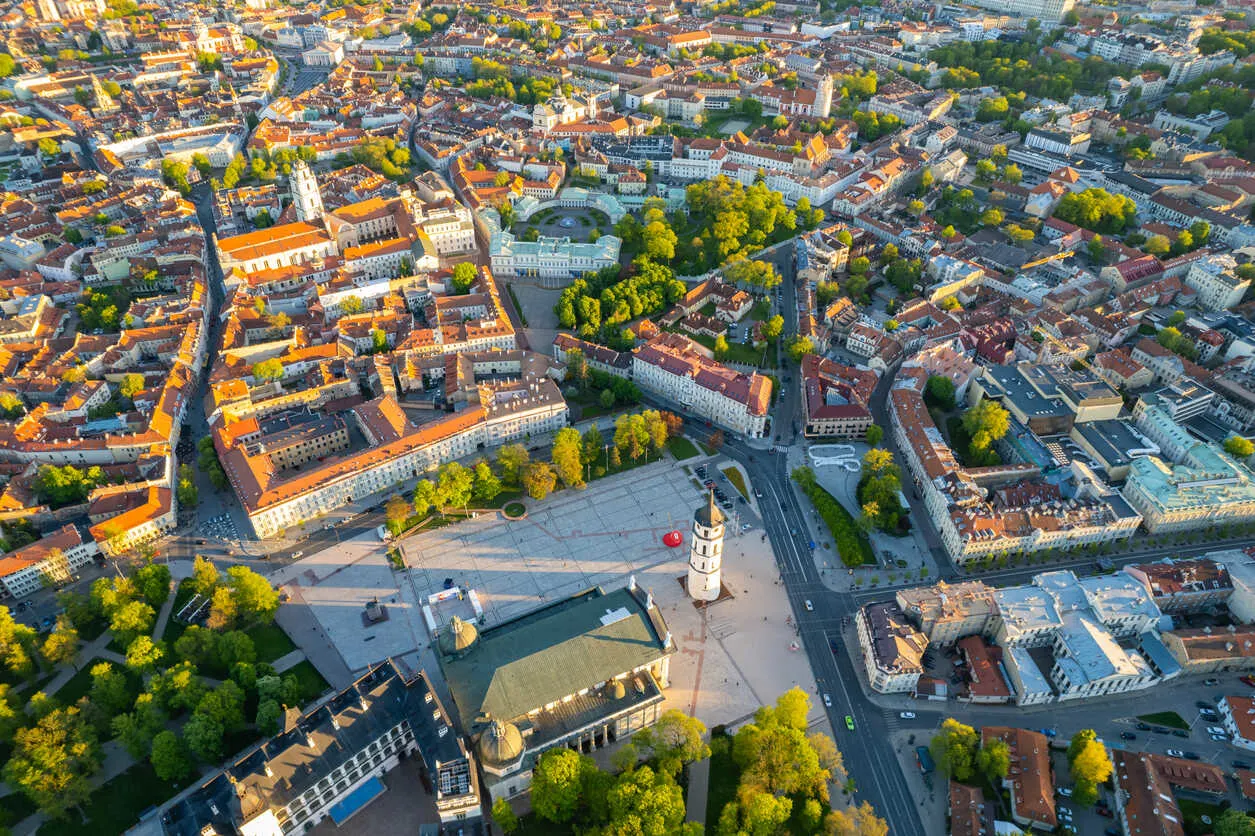
Air: Air travel to Lithuania is convenient. Vilnius International Airport (VNO) is the main gateway, with connections to numerous European cities. Various budget airlines provide affordable options. We flew Baltic Air and found them to be of good value, on time, and with excellent customer service. Once in Lithuania, domestic flights are available to destinations like Kaunas and Klaipėda.
Trains: Train travel in Lithuania offers a comfortable and efficient way to explore the country. Modern trains connect vital cities like Vilnius, Kaunas, and Klaipėda. Trains are known for their punctuality, cleanliness, and affordability. Onboard amenities often include spacious seating and high-speed Wi-Fi. The railway system is well-developed, making it easy to navigate.
Bus: Bus travel is convenient, efficient, and cost-effective. It’s a popular choice for locals and tourists. The bus network connects major cities like Vilnius, Kaunas, and Klaipėda, as well as smaller towns. Buses are generally modern, comfortable, and equipped with amenities like Wi-Fi. Timetables are reliable, with frequent departures throughout the day. Many bus operators offer online booking.
Taxis: Taxis are widely available and generally affordable. In major cities like Vilnius and Kaunas, you can hail a cab or use ride-hailing apps like Bolt or Uber. Most drivers speak basic English.
Auto: Owning a car in Lithuania offers convenience, especially for exploring the countryside. The road infrastructure is generally well-maintained, with modern highways and scenic routes. Driving in urban areas like Vilnius and Kaunas can be challenging due to traffic and limited parking. However, navigating smaller towns and rural areas is much easier. It’s worth noting that fuel prices can be relatively high, and having a navigation app is vital. Owning a car in Lithuania is straightforward. However, only residents can register a vehicle.
Ferries: Ferry travel in Lithuania offers scenic journeys across the Baltic Sea, connecting mainland cities like Klaipėda to the Curonian Lagoon and the nearby Neringa Peninsula. Modern ferries provide comfortable amenities for passengers. These trips also allow access to beaches, villages, and nature, for day trips or weekend getaways.
Cycling and Walking: Walking or cycling is a great way to explore the countryside and cities. Many cities, like Vilnius and Kaunas, are equipped with well-maintained bike paths and pedestrian-friendly streets. The countryside has numerous cycling trails that wind through forests, lakes, and villages, perfect for outdoor enthusiasts. Lithuania hosts cycling events and promotes eco-friendly transportation. Numerous walking tours illuminate the rich history and architectural beauty. It is a lovely way to immerse in Lithuanian culture while staying active.
Entertainment and Things to Do
Lithuania offers a delightful entertainment scene blending cultural and recreational activities.
Over 35 museums, art galleries, and theaters offer local and international talent in Vilnius. The Old Town, a UNESCO World Heritage site, is perfect for strolls amid medieval architecture.
Kaunas hosts cultural festivals and events, while its parks and riverside promenades invite outdoor activities.
Klaipėda, the coastal gem, has beautiful beaches, nature trails, and lively cultural events celebrating its diverse heritage.
All over Lithuania, dining options range from traditional Lithuanian cuisine to international fare, featuring budget-friendly and Michelin-starred choices.
Residency, Visas, Etc.
As with all Schengen Area countries, you may stay in Lithuania for 90 days within the past 180 days. If you wish to stay longer, you must apply for a Temporary Residence Permit. These can be renewed each year. You can apply for permanent residency after five years as a temporary resident. Lithuania does not have a Digital Nomad or Pensioner residency program. However, there are visas for students, workers, and start-ups.
Healthcare
Lithuania’s healthcare system is a mixed model, combining public and private services. Funded primarily through taxation, it offers all citizens and residents universal health coverage, including expats.
The system provides primary care through family doctors, while hospitals cater to specialized needs. Quality of care has improved significantly with investments in infrastructure and technology. However, challenges remain, including long waiting times for some procedures and a shortage of healthcare professionals.
Lithuania’s focus on enhancing healthcare services aims to ensure accessible, affordable, and high-quality medical care for its population, making it appealing to retirees considering moving there.
10 Reasons to Retire in Lithuania
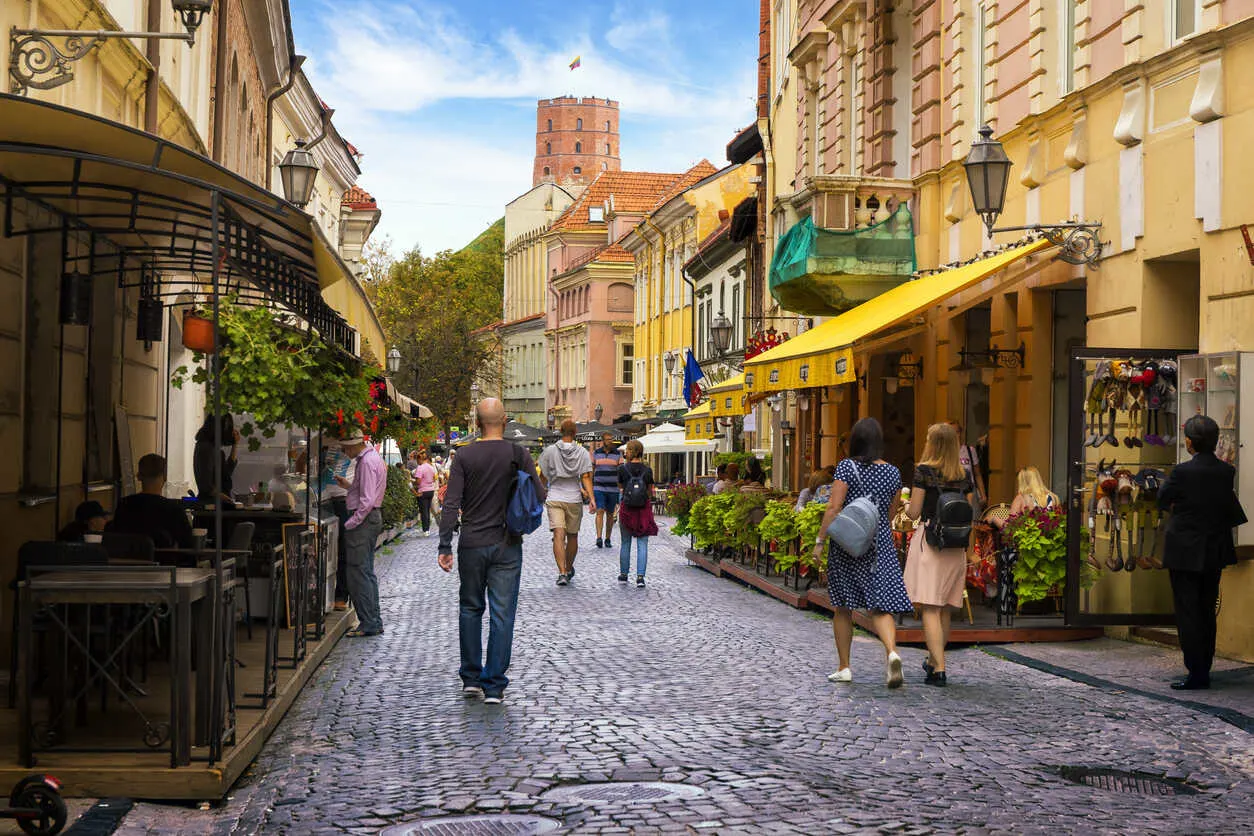
1. Affordable Cost of Living Lithuania’s cost of living is lower than that of many Western European countries and the US, making it easier for retirees to live on Social Security or stretch their savings.
2. Rich Cultural Heritage The country has a vital history and culture, with numerous museums, historical sites, and cultural festivals to explore.
3. Scenic Nature Lithuania is home to beautiful landscapes, including lakes, forests, and the Baltic Sea coastline, providing ample opportunities for outdoor activities.
4. Free Healthcare Lithuania has a well-developed healthcare system, with accessible medical services and European standards for healthcare quality. All citizens and residents qualify for free state health care.
5. Friendly Communities The local population is known for their hospitality, making it easy for retirees to integrate and form connections.
6. Variety of Activities There’s always something to do, such as exploring historical cities like Vilnius and Kaunas, immersing in nature, enjoying the visual and performing arts, and savoring dining and entertainment.
7. Good Transportation The country features efficient public transportation, including planes, trains, and buses, making it easy to travel within Lithuania and neighboring countries.
8. Mild Climate Lithuania experiences four distinct seasons, offering a pleasant climate with warm summers and snowy winters, ideal for those who enjoy seasonal changes.
9. Safety and Stability Lithuania is considered one of the safer countries in Europe, with a low crime rate and political stability.
10. Language Accessibility While Lithuanian is the official language, many people speak English, especially in urban areas, making communication easier for expats.
Conclusion
We think retiring in Lithuania is a good option for those seeking a new life in Europe. The blend of culture, affordability, and active lifestyle put it on our “We could live there” list. From the distinct landscapes and historic streets of Vilnius to the coastal charm of Klaipėda, you can enjoy a high quality of life without breaking the bank. Lithuania’s welcoming communities and active arts scene create a fulfilling lifestyle. Access to healthcare, outdoor activities, and a rich history make it a smart choice for those seeking an enriching retirement in Europe.
How To Move Out of the U.S.
How To Move Out of the U.S.
The policy implications of the last election impacted your retirement funds, taxes, healthcare, and more. But you can protect yourself, your family, your future. In lots of safe, warm, friendly spots abroad, you can live comfortably on a budget from $2,000-$3,800 a month (all-in—housing and extras included). We’ll show you how—and where—to go.

By submitting your email address, you will receive a free subscription to IL Postcards, The Untourist Daily and special offers from International Living and our affiliates. You can unsubscribe at any time, and we encourage you to read more about our Privacy Policy.
